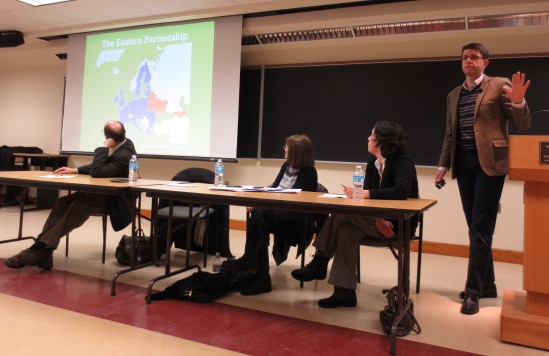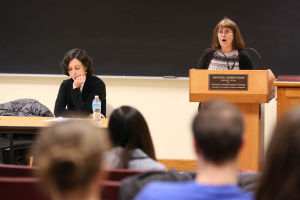This is a re-posting of a blog post by Illinois alumna Areta Kovalsky. To view the original post, please see http://shadowsofaforgottenworld.blogspot.com/2014/04/euromaidan-wwii-parallels-and-feelings.html.
_______________________________________________________________________________
This post is dedicated to EuroMaidan and the Ukrainians’ never-ending struggle to be free. These past few months, as I experienced a revolution and war for Ukraine’s freedom and integrity, I have often thought of my ancestors and how they must have felt during WWII (and earlier liberation movements) and the partisan struggle to liberate Ukraine from totalitarian powers. I’ve always been fascinated by WWII and the Ukrainian Insurgent Army (UPA), but never in my life did I think I would feel what they felt, get a taste of war, death, and the fight for freedom, such uncertainty, and love for Ukraine in a context similar to theirs. Tying into the theme of my blog, this particular “shadow of the past” is one that I have felt rather than seen. I have encountered what I will call “feelings from the past.” These sentiments which were felt by Ukrainians in WWII have been transferred to a new generation of Ukrainians who are reliving the liberation movement, re-struggling for a free, prosperous, and democratic Ukraine. Of course, EuroMaidan and Russia’s recent invasion of Ukraine in no ways compares to the scale and consequences of WWII, and I don’t pretend to believe I understand the extent of the suffering that the people felt at that time (especially as I wasn’t in Kyiv during the bloodiest days), but nonetheless, I can’t help but draw certain parallels.
***
I remember one day in late February I was walking toward the Old Town from work. It was dusk and as I walked along the cobblestone streets, in the distance between the Austrian-era buildings I saw on the city hall tower’s the Ukrainian flag flapping in the wind. I immediately thought about how much Ukrainian blood had been spilled for it to be there. I couldn’t believe that in the year 2014 Ukrainians yet again had to fight for their freedom, fight against a new type of feudalism, new type of Russian imperialism, a new totalitarian power. Ukraine had been independent for just over two decades – the longest it has been a free country since the Middle Ages, the longest a blue and yellow flag had been able to fly safely on Ukrainian land – when again its sovereignty was being threatened.
The flag flies proudly in Lviv, but during the revolution, displaying the yellow and blue banner was an anti-government act, and my mother was even worried for my safety in Lviv because I had a yellow-blue ribbon on my purse and she told me to be careful at night in case some gave me trouble for it…
 Looking at the flag, I thought about all the people who had fought for a free Ukraine throughout the ages, but in particular about the heroes of the Heavenly Hundred who had just been shot down in the center of Kyiv. The heroes, mostly young men, couldn’t sit home while their future was being robbed. I heard so many stories from WWII about families being torn apart, about lost husbands, fathers, brothers. Was it really happening again, in the twenty-first century? Never in my life did I think I would be re-feeling some of what my grandparents felt when they were close to my age, re-living a similar struggle. It all felt so surreal.
Looking at the flag, I thought about all the people who had fought for a free Ukraine throughout the ages, but in particular about the heroes of the Heavenly Hundred who had just been shot down in the center of Kyiv. The heroes, mostly young men, couldn’t sit home while their future was being robbed. I heard so many stories from WWII about families being torn apart, about lost husbands, fathers, brothers. Was it really happening again, in the twenty-first century? Never in my life did I think I would be re-feeling some of what my grandparents felt when they were close to my age, re-living a similar struggle. It all felt so surreal.
I sometimes think that the main reason I moved to Ukraine, the reason I am so drawn here, pulled here by some forces, is because I needed to return to Ukraine in place of my grandparents who were forced to leave their beloved country, and who themselves were never able to return. I feel that I was guided to Ukraine because the love for and attachment to Ukraine was passed down from my grandparents, and as they couldn’t return, I am doing it for them. To me it really does feel like I returned home even though I was born and grew up in a completely different country and culture.
However, within a few months of obtaining my permanent residency, settling into a promising new job, feeling ready to settle down, Ukraine was caught it yet another war for its independence. It started as a peaceful revolution, first for closer ties with the EU, then against corruption, lack of rule of law, and a totalitarian government. Eventually the center of Kyiv became a real battlefield, a frontline between Ukrainians who just wanted a better a future and the paid government police and hired thugs defending the money and opulence of the government.

Barricades at Maidan in Kyiv (December 2013)
My grandparents’ generation fight for freedom didn’t succeed, there was no independent Ukraine after the war, and so being intelligentsia and having taken part in the liberation struggle, my relatives would have been persecuted under the Soviets. Thus in 1944 when the Soviets were again approaching western Ukraine, my grandparents had to flee west. During EuroMaidan, I remember thinking that one of the reasons that EuroMaidan had to succeed was so that the active members would not be persecuted. Many people took risks by defying the government, like the mayor of Lviv, the administration and many of students of the Ukrainian Catholic University in Lviv, etc, and they would have all have been punished for it in one way or another…

A Sunday national assembly on Maidan in Kyiv in December
I remember even when the revolution was just beginning, and all the organizing that was taking place, when people were finding food and shelter for people who wanted to go to Kyiv and protest, I couldn’t help but be reminded of the way families in the villages sheltered and fed the partisans during WWII. Eventually sotnias (defense/military units) were formed during EuroMaidan and I couldn’t help but think that the last time sotnias were formed was during the war by the UPA.

Barricades in the center of Lviv – probably the last time Lviv was barricaded was during WWII
The UPA slogan “Glory to Ukraine” and response “Glory to the Heroes” as well as UPA songs sounded from maidan’s across the country, and the black and red UPA flags flew next to the yellow and blue ones. There are in fact a lot more parallels between WWII and EuroMaidan/the Russian invasion…
***
And once we finally had a taste of victory, finally ousted the corrupt president, finally felt we had a chance to completely reboot the country, root out the Soviet mentality once and for all, put an end to corruption, we realized we were up against something potentially a lot more serious and even more unpredictable – the superpower to our north-east. Although our taste of victory was bittersweet, as it was tainted with the grief we felt for the heroes who lost their lives, we felt that the country had changed for the better, that more was accomplished in those few months than the 20 plus years of Ukrainain independence. After the Yanukovych government was disbanded, I felt as if I were living in a new country, it felt easier to breath, things were starting to look up, and I felt like the deaths were not in vain. But less than a week after the government was overthrown we were faced with war. Russia invaded and annexed Crimea and currently Russia’s attempts to destabilize Ukraine are only increasing. The situation in eastern Ukraine is very serious and it seems Putin has no intention to stop the aggression.
When the invasion first began, my foreigner friends and I were often asked if we planned to leave Ukraine. I never considered it for a moment. My mom told me I could stay with my parents’ friend’s parents in Poland if I did have to leave. And just the other day she said her friends in the States asked her if I have an exit strategy. I don’t think the conflict will ever physically reach this part of Ukraine, but it was and still is a scary time to be in Ukraine. If the conflict did spread, I, like my grandparents, would have to make the difficult decision of deciding whether to stay or leave. Of course my move wouldn’t be nearly as difficult as theirs was – I wouldn’t have to make a fresh start in a country where I don’t know the language, leaving behind close relatives and the only life I had – but it would still be heartbreaking for me.
Almost every time I talk to my mom she tells me to think about what I would take with me if I needed to make a quick escape from Ukraine. It made me think about what my grandparents took with them when they left Ukraine. Very few things of theirs from their lives in Ukraine have survived. They couldn’t take a lot with them and a lot was lost, stolen, or broken along the way. They took photos, documents, a china set (only one mug survived with a broken ear), some embroidery (pillow cases, portières), kilims, jewelry, wedding rings, a balsam wood cross from Jerusalem. My mom said to make sure I take my antique embroidered blouses.

Center of Lviv after the bloody events in Kyiv
Spring has arrived in Lviv, the summer terraces have been built, on the weekends the center is packed with tourists and locals – life goes on, but we are all still very worried about what is happening in the east of our country and no one has any idea how things will end…
And we have not forgotten about the fallen heroes – memorials, graffiti, shrines, billboards commemorating them are found all over the city. Now in addition to the Heroes of UPA Street, Lviv has a street named after the Heroes of EuroMaidan. Just as the heroes of WWII have not been forgotten, they live on in the people, memories, urban landscape, hearts, so to the heroes of EuroMaidan live on.

One of the first shrines in Lviv to the fallen heroes
I hope one day these particular feelings from the past will stop being passed on to new generations, and instead only the feelings of love and pride will be passed on.
Areta Kovalsky graduated from the University of Illinois at Urbana-Champaign with a major in International Studies and an undergraduate minor in the REEEC degree program. She went on to get a master’s degree in Eastern European Studies from the University of Toronto. The last couple of years, she has been living in Lviv, Ukraine, working as a translator and for various IT companies.

























